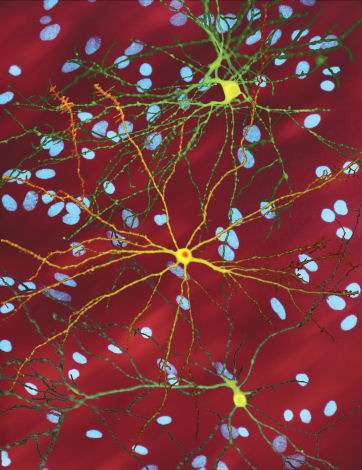by Technion – Israel Institute of Technology

A montage of three images of single striatal neurons transfected with a disease-associated version of huntingtin, the protein that causes Huntington’s disease. Nuclei of untransfected neurons are seen in the background (blue). The neuron in the center (yellow) contains an abnormal intracellular accumulation of huntingtin called an inclusion body (orange). Credit: Wikipedia/ Creative Commons Attribution 3.0 Unported license
Huntington’s, Alzheimer’s, ALS, and multiple other neurodegenerative diseases share a commonality: They are all characterized by proteins (different ones for each disease) aggregating in neurons within the brain and nervous system. Now, Technion Israel Institute of Technology scientists have found that the cells have the mechanisms to clear those aggregates—they just fail to activate them. Their study was recently published in Nature Communications.
Proteins are the building blocks and the functioning units of our body. Any time the body needs something done, specific proteins are generated to accomplish it. To do this, the code for the particular protein is read from the DNA, and the protein is built from sub-units called amino acids. It is then folded into the 3D shape it needs to assume. Other proteins, called “chaperones,” assist in this folding process.
Aggregates form when certain proteins form incorrectly. Instead of performing the function they were supposed to perform, they attach to each other, creating sizeable clusters that not only are useless, but also disrupt the cells’ normal functionality. Ph.D. student Kinneret Rozales and M.D./Ph.D. student Amal Younis, working as part of the research group of Professor Reut Shalgi, examined how the cells respond to the aggregates building up inside them.
How can we know how a cell feels? We cannot ask it whether it is happy or in pain. But we can examine which genes the cell expresses. We know the cell would activate certain genes when it feels stress. On the other hand, if everything is fine, those genes would not be activated.
Some of what the cell does in response to stress is activating specific chaperones, in an attempt to correct or remove misfolded proteins. But which chaperones are activated? And which ones are needed to solve the problem? A great many different chaperones are encoded in the human DNA. Rozales and Younis examined 66 of them in cells with Huntington or ALS-associated protein aggregates. Some chaperones, they found, only make things worse. But quite surprisingly, they also found chaperones that could eliminate the aggregates, curing the cell. The tools to cure the disease are already within us, encoded by our own DNA.
Why then, if the necessary chaperones exist, do they not cure patients’ cells before neurons degenerate? “It is not enough that the tools exist in the cell’s toolbox,” said Prof. Shalgi. “The cell needs to realize there is a problem, and then it needs to know which, out of the many tools available to it, it should use to solve the problem.”
Unfortunately, the group found, this is where the bottleneck lies. In cells with Huntington-associated protein aggregates, the cells sensed there was a problem, and activated some stress-response chaperones, but not the correct ones. The cells did not know what was causing the stress, or what they should do to correct the situation. With ALS associated aggregates, things were even worse; the cells did not realize that they need to activate chaperones at all and displayed no signs of stress.
“The cell is a complicated system,” said Prof. Shalgi in explaining the surprising findings. “Think of your computer: When something is wrong, sometimes you do not realize it at first. It just responds a bit slower than it used to, perhaps, or it throws an error message that you ignore and forget. When you do realize something wrong—in the way of a blue screen or a refusal to start, you, or a technician on your behalf, attempt to diagnose and solve the problem. Sometimes the solution is found straightaway, but other times it is something that you never encountered before, and you don’t know which driver needs to be installed, or piece of hardware needs to be replaced. It is the same with our cells: They do not always realize there is a problem, or know how to solve it, even when they do in fact have the tools to do so. The good news is that since the ability is there, we hope future treatments can be developed to activate it and employ the body’s own tools to cure these debilitating neurodegenerative diseases.”

Leave a Reply